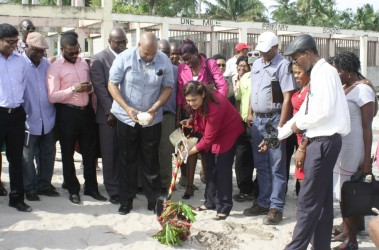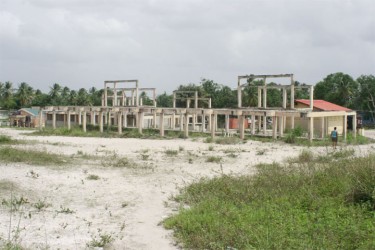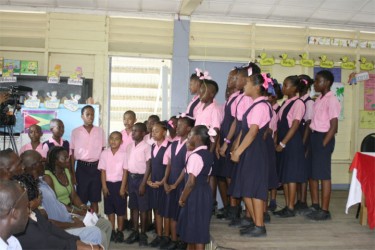By Jeff Trotman
The One Mile Primary School, which was destroyed by fire during the 2012 July/August electricity protest in Linden, will be replaced by a state-of-the-art institution by February 2015.
Minister of Education Priya Manickchand turned the sod to launch the construction of a new $170 million school on Wednesday.
The minister, who was accompanied by a team of government officials, including Chief Education Officer Olato Sam and Minister in the Ministry of Finance Juan Edghill, also participated in a consultation exercise at the Wismar Hill Primary School with Region Ten officials, parents and displaced pupils of the One Mile Primary School.

During her discourse at the Wismar Hill Primary School, Minister Manickchand called on concerned citizens to monitor the quality of work being done during the construction process and to inform the Ministry of Education of any concerns via hotline, Facebook and a website that would be established by the ministry.
The minister said the school would be completely constructed by February 2015, within a year of the signing of the contract between the Education Ministry and PD Constructing Co. She also disclosed that the construction works will be monitored by a separate company, Kalitech Inc.
Regional Education Officer (REdO) for Region Ten Marcia Andrews, who chaired the consultative exercise, pointed out that 826 children and 43 teachers were displaced and had to be housed at three different locations, which posed a number of problems.
She pointed out that despite the challenges, the school maintained full enrolment, recording 94% punctuality and 97% attendance from pupils; 75% punctuality and 96% attendance from teachers.
The REdO expressed thanks to the parents, teachers, children and all other stakeholders, who remain committed to educating children in the community.
Proud moment
During the consultation exercise, Regional Chairman Sharma Solomon said it was a proud moment for the children of Linden and in particular the pupils of the One Mile school. He said the school was built in the rich tradition of self-help that was part of the people of Region Ten. The high punctuality and attendance of the school even after its destruction is indicative of the commitment of the pupils and their parents to education, he added.

He said that on November 29 at the bilateral discussions between the regional administration and the government, the first proposal of $60 million was deemed inadequate by the region. He expressed the belief that the insistence on the part of the region for “a complete programme” resulted in the $170 million being spent. He said he was grateful for that position adopted by the government to ensure that all the pupils of the One Mile school could once again be housed under one roof.
He was confident that the contractor will do quality work and optimistic that the requisite skilled labour will be garnered from within the community and region. He also commended those persons who began the rebuilding process through self-help and contributions in the form of materials. In this regard he commended a local wholesaler, B Harry for his substantial contribution of building material towards the self-help aspect of the rebuilding of the school.
He said the building committee would have acquired materials and would be willing to report on what had been done to support the rebuilding exercise.
Meanwhile, Minister Manickchand said she was happy to see that parents made the sacrifice to ensure that their children attended school and that punctuality was in the high nineties despite the difficulty they must be enduring owing to the dislocation.

However, she expressed disappointment at the comparatively low punctuality of teachers. She said Linden is the only community in Guyana with 100 per cent trained teachers. Pointing out that people have been asking for the training school in Linden to be closed, Manickchand said the high percentage of trained teachers in Linden was not reflected in the riverain areas in Region Ten and this was a matter that has to be resolved because all the teachers want to stay in Linden.
She said that when she held consultations with the parents of the pupils after the school was destroyed, one member of the audience was heckling that they did not want government’s intervention in rebuilding the school but she could discern from the expressions of the parents faces and their deportment that they disagreed with him. Pointing out that rebuilding a school calls for a lot of money and proper planning, Manickchand stressed: “That kind of leadership, whether it stems from lack of knowledge or ignorance or anger … is nothing but destructive.”
She said that 835 pupils had been dislocated and the Ministry of Education had asked for $160 million to rebuild the school but the planners in the Ministry of Finance said they couldn’t put up that money because Linden had a school rebuilding committee, led by the Regional Chairman and the Ministry of Finance would put up matching funding. Consequently, the Ministry of Education received $60 million in the 2012 budget, which was supposed to be added to the funds of the rebuilding committee.
The Education Minister said as soon as that money was available, the Regional Chairman was contacted and he along with his team held discussions on how the rebuilding should proceed, particularly in compliance with the Procurement Act.
She said the Education Ministry did not hear from the Region’s team for some time but subsequently learnt through an article in the Guyana Times that the rebuilding committee was no longer going to rebuild the school – that the Ministry of Education would do it. She said the Ministry of Education then so informed the Regional Chairman.
Stating that she did not have to push for Cabinet to agree to finance the rebuilding project, Manickchand said Cabinet also agreed with her proposal that instead of building a school that catered for 300 students it was better to build a new school that catered for over 800 pupils and more.
Commitment
Minister Edghill said that while he was happy to be at the launching of the rebuilding of the One Mile Primary School, he would have been much more upbeat if the exercise had been the launching of the construction of a new school “because the fact that we have to rebuild what was destroyed by fire, was a dark day for Guyana.”
He stressed that $170 million of taxpayers’ money was being spent on rebuilding a school while several communities in the country are still waiting to get their first school. Noting that the government was not rebuilding the school for show, the minister said that from the time the school was destroyed, Minister Manickchand had canvassed the government to put in place all the necessary arrangements to ensure that the delivery of education to all those 826 pupils continued.
Highlighting that the government does not play politics with children, Edghill said that the displaced pupils of the One Mile Primary School “were not supposed to be pawns in anybody’s political game”. He noted that 30% of the government’s expenditure goes to the social sectors – health, housing education and water – with education having about 10% of that budget. He said Guyana has achieved universal primary education and is almost there in the quest for universal secondary education.
“We have put in place the necessary financing and mechanisms to ensure that teachers are trained, schools are built, children in areas where there is transportation difficulty, they get to go to school, we have provided uniforms for the children to attend school and up to a certain level provide meals to ensure that those children are able to go to school … and that programme is country wide. That is the kind of commitment that we make,” Edghill said.





